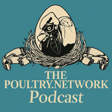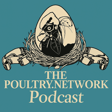
Ep. 14 Tri-SoMe CHICKEN: Mapping resilience in the UK broiler machine
In this episode, hosts Tom Willings and Tom Woolman speak with Dr Paul Hurley (University of Southampton) and Dr Pippa Simmons (University of Gloucestershire) about Tri-SoMe CHICKEN — a three-year, UKRI-funded project examining the resilience of the UK’s chicken meat system. With chicken now accounting for around half of UK meat consumption, the team argues that understanding where the broiler sector bends or breaks under pressure is a national food-security question, not a niche academic exercise.
What sets this project apart is its “socio-metabolic” lens. Rather than model only physical supply-chain flows, the researchers are mapping how materials, practices, power dynamics and consumer behaviours interact across a tightly integrated system — from genetics and feed to processing, retail and what ends up on the plate. The work is being built with extensive industry input so the outputs are practical, not theoretical.
Where the system is most exposed
- Disease and biosecurity — Avian influenza remains a first-order risk and the team is linking with parallel AI research to avoid duplication and widen the view.
- Climate shocks — 2022’s extreme heat is a case study. Beyond shed environments, prolonged temperatures over 40°C challenge cold-chain reliability and plant operations. The question is whether current infrastructure and incentives are ready for more frequent, hotter events.
- Feed markets — The system is optimised around soy. Geopolitics and trade shifts since Russia’s invasion of Ukraine have pushed input prices higher and re-routed global flows (e.g., China sourcing more from Brazil). As a relatively small buyer, the UK’s access and pricing remain vulnerable.
- Just-in-time fragility — High efficiency and vertical integration are strengths — until a single dependency fails. The 2022 CO₂ shortage, intertwined with gas and fertiliser markets, showed how quickly plant-level stunning capacity can become a bottleneck with immediate welfare consequences on farm.
Public perception vs production reality
New to broilers after work on cattle and sheep, Simmons highlights a deeper public disconnect with chicken than other species — few outside the sector grasp the separation of meat and egg lines, or how changes such as down-stocking from 38 kg/m² to 30 kg/m² ripple into carbon footprint, costs and throughput. Better dialogue is needed so welfare, sustainability and affordability trade-offs are understood, not assumed.
What ‘good’ could look like
The team is not writing another prescriptive standard. Instead, they are developing a flexible ethical framework — a set of principles stakeholders can use to weigh options when shocks hit or when policy and market changes tweak the system. Crucially, that means enabling long-term investment in resilience (heat-hardening sheds, stronger cold chains, alternative feed strategies) at a time when financial pressure pushes operators to think quarter-to-quarter.
Call for farmer input
A major workstream now underway is interviewing broiler farmers across geographies and systems — including different litter, energy, and waste strategies — to capture what resilience looks like in everyday practice. If you run broilers and are willing to contribute, contact details are in the show notes and on the Poultry.Network episode page.
Trade-offs for a Resilient Broiler Sector – An Industry Stakeholder Workshop SAVE THE DATE: 23 October 2025 10:00-16:00 Edgbaston Park Hotel and Conference Centre, Birmingham, B15 2RS. Email to register: resilient.chicken@soton.ac.uk

